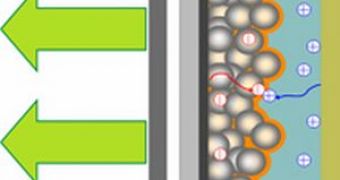How many times have you missed your favorite show because you were not at home...
That's why a pocket TV would do good.
With all the current technology of the flexible video displays based on organic light emitting diodes, a television still cannot be rolled up and put in your pocket. This frustrating situation could soon end, as researchers have found a novel formula to improve the flexibility of a key component.
Organic LEDs are a viable alternative to other technologies, like solid-state or plasma displays. LEDs consume much less power as they do not need backlighting, and their fabrication is much easier and cheaper.
The classic design uses two flat electrodes with a layer of light-emitting organic compound in the middle. One of the electrodes is usually fabricated from a reactive metal, which frays in time due to oxidation with the oxygen from the air, shortening the device's lifetime. If the electrodes are wrapped in plastic material, it will be guarded by the air, but the plastic layer decreases flexibility.
But a team at Imperial College London built organic LEDs without any wrapping material by substituting the reactive metal electrode with nanostructured titanium dioxide, an extremely porous compound, used also in the composition of solar cells, whitewash and toothpaste.
The compound has revealed its remarkable qualities in solar cells, but only now it has been tried in LEDs. The spongy surface of titanium dioxide offers a 1000-times larger area for the light-emitting layer. "Fine-tuned designs could produce more light, for longer, at lower voltage," said Saif Haque, lead author of the study.
In fact, titanium dioxide could eliminate the current encapsulation necessity in a lot of technologies, resulting in more flexible and long-lived devices. "It's a timely and smart assimilation of ideas from different fields," says physicist Richard Friend of the University of Cambridge in the U.K. "Researchers need to demonstrate that the designs are more efficient before they will be viable for applications. But if that work pans out, it could make for displays that would fit in your pocket but don't drain your pocketbook."
Image credit: Saif Haque. Titanium-dioxide spheres, wrapped in a light-emitting organic molecule (orange), sit between glass (left) and gold contacts

 14 DAY TRIAL //
14 DAY TRIAL //